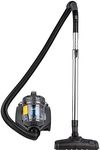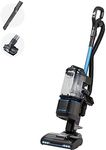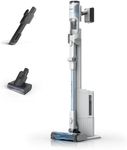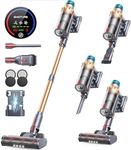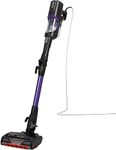Buying Guide for the Best Vacuums For Thick Carpets
When choosing a vacuum for thick carpets, it's important to consider features that will effectively clean deep into the carpet fibers without causing damage. Thick carpets require vacuums with strong suction power and the ability to adjust to different carpet heights. Additionally, ease of maneuverability and maintenance are key factors to ensure a smooth cleaning experience. Understanding the specifications that matter most for thick carpets will help you make an informed decision and find a vacuum that meets your needs.Suction PowerSuction power is the force with which a vacuum pulls in dirt and debris. For thick carpets, strong suction is crucial to reach deep into the fibers and remove embedded dirt. Suction power is often measured in watts or air watts. Higher values indicate stronger suction, which is beneficial for thick carpets. However, too much suction can make the vacuum difficult to push. Look for vacuums with adjustable suction settings so you can tailor the power to your carpet's needs.
Brush RollThe brush roll is a rotating brush that helps agitate carpet fibers to loosen dirt. For thick carpets, a motorized brush roll is essential as it provides the necessary agitation to clean effectively. Some vacuums offer adjustable brush roll heights or the ability to turn the brush roll on and off, which can be useful for transitioning between carpet and hard floors. Choose a vacuum with a brush roll that can be adjusted or turned off to prevent damage to delicate carpet fibers.
Height AdjustmentHeight adjustment allows the vacuum to be set at different levels to accommodate various carpet thicknesses. This feature is important for thick carpets to ensure the vacuum can glide smoothly without getting stuck. Vacuums may have manual or automatic height adjustment. Manual adjustment gives you control over the setting, while automatic adjustment adapts to the carpet height as you clean. Consider your preference for control and convenience when choosing between these options.
Filtration SystemA good filtration system traps dust and allergens, preventing them from being released back into the air. This is particularly important for households with allergies or pets. HEPA filters are highly effective and can capture small particles, making them a great choice for maintaining air quality. When selecting a vacuum, consider the type of filtration system and how easy it is to clean or replace the filters. A vacuum with a high-quality filtration system will contribute to a healthier home environment.
Weight and ManeuverabilityThe weight and maneuverability of a vacuum affect how easy it is to use, especially on thick carpets. Heavier vacuums can be more challenging to push and pull, while lighter models are easier to handle. Look for vacuums with swivel steering or other features that enhance maneuverability. If you have a large area of thick carpet, a vacuum that is easy to move around will make the cleaning process more efficient and less tiring.
Bagged vs. BaglessVacuums come in bagged and bagless models, each with its pros and cons. Bagged vacuums tend to hold more dirt and are less messy to empty, which can be beneficial for allergy sufferers. Bagless vacuums eliminate the need to buy replacement bags and often have clear canisters so you can see when they need to be emptied. Consider your preference for convenience and maintenance when deciding between bagged and bagless options.

